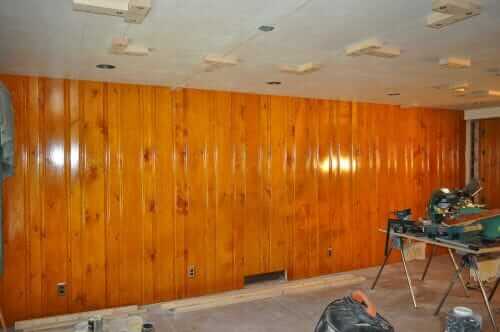
 Another doing-thing-The-Hard-Way Retro Renovator here: Daniel discovered, searched, found, drove to get, stained and installed this beautiful wall of pickwick pine in the living room of the 1956 house he has been working on. He has great tips to share — like, how he got that classic knotty pine color just right — but he also has a question for us: Should the faux beams he’s adding be darker in color than the pine, or the same color?
Another doing-thing-The-Hard-Way Retro Renovator here: Daniel discovered, searched, found, drove to get, stained and installed this beautiful wall of pickwick pine in the living room of the 1956 house he has been working on. He has great tips to share — like, how he got that classic knotty pine color just right — but he also has a question for us: Should the faux beams he’s adding be darker in color than the pine, or the same color?
From Daniel, edited a bit:
Hi Pam,
Hi! I just want to first let you know I love your site! I’m on it almost daily using it for reference material. I own a 1956 brick ranch and I’m in the process of bringing it back to the former glory that is mid-century. I love all things retro and vintage.
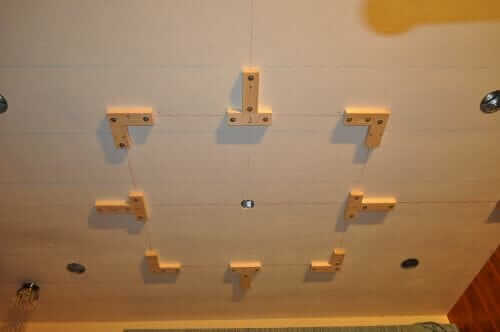
I’m currently working on the living room. I’ve done one accent wall with pickwick paneling and made a bookshelf that is somewhat built in. (it isn’t recessed but it is attached to the wall). I’m adding faux beams to the ceiling and this brings me to my question. The pickwick was finished with 2 coats of amber stain by General finishes, 2 coats of clear shellac and 3-4 coats of amber shellac (what a process, but results were fantastic!).
I’m wondering what to do for the beams though; do I finish to match the paneling or do I go darker to contrast the paneling. I wouldn’t want it to be dark, dark brown but I’m thinking maybe a shade or two darker (just a hint of brown) would be nice. Then again, maybe the same color as the paneling would be acceptable. The beams will be pine boards similar to what you would find at Home Depot. I’m not sure if it’s exactly considered knotty pine, but it is pine.
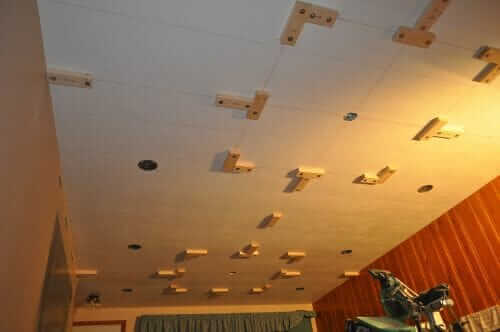
The room is literally a construction zone right now, so there is no decor, flooring (aside from sub-floor) or much else to base opinions on. [In the photos you can see] the wall with pickwick paneling and the frame work for the beams as well as the design I made illustrating the layout of the beams. Hopefully this will help and I sincerely appreciate any help and opinions from the readers! Thanks!
Very cool! That knotty pine indeed looks amazing! Of course, I asked Dan for some more info about the house and how he got into The Retro. Oh, and you’ll see I also nudged him suggesting that he might want to consider wallpaper on the ceiling — like in Brian and Keri’s den, dreamy!.
- Knotty is Nice: All our stories about Knotty Pine.
Dan wrote:
The house was built in 1956 and has (sort of) been in the family ever since. My Grandmother’s Godmother and her husband had the house built. Both my Grandmother and Grandfather acquired the house in 1997 and lived in it until they both passed. I’ll be purchasing the house in a couple of months but have done tons of work in it over the years. My Grandfather was a self taught carpenter (mostly finish carpentry) after he retired from the Fire Department in 1988. I took an interest in woodworking ever since I was old enough to work with him but unfortunately he gave it up by the time I was old enough to really delve into it. Pretty much everything I know I learned through trial and error and just doing.
I’m not quite sure when all this mid-century/vintage/retro stuff sparked an interest for me but for as long as I can remember, I always loved the somewhat simplistic and (sometimes) chaotic (think clashing, bright colors on carpets, furniture, etc) look that is mid-century. Recently, I’ve really come to appreciate the craftsmanship that went into building these old homes: the natural woodwork, solid wood cabinetry, chrome trim around counter-tops, top notch building materials, the list goes on. It’s clear they took pride in their work, and while there’s certainly still builders around who do, I think a lot of that has fallen by the wayside for faster and cheaper building methods.
As for this current project, I searched high and low for years as to what kind of paneling I’m putting up, and I finally stumbled upon your site and it cleared it up for me. I was so happy to figure out what it finally was. My parents have this paneling in the living room of their 1956 Cape Cod. Unfortunately, my Mom convinced my Dad to paint it years ago and that was before I had a real appreciation for this stuff. I now have a strict “no painting natural woodwork” policy. I do painting and wallpapering on the side and have turned down many jobs where people wanted to paint the natural woodwork in their homes. I just can’t bring myself to do it.I drove from Buffalo, NY, to Middletown, PA, with a pickup truck to get all the paneling I needed. I was going to buy enough to do a small wall in the dining room too but unfortunately, a lot of the paneling at the yard was damaged when it got shipped to them so I was only able to get enough to do the living room wall and the back wall of the book case with a couple boards left over.Staining and finishing was a huge undertaking, and I’ll likely never do a job again this large. I found a stain that nearly hits the nail on the head in matching the original woodwork in the house which is General Finishes Amber Dye. To cover that I did two coats of clear shellac and 3-4 coats of amber shellac. It was my first time working with shellac on such a large scale, and there is definitely a learning curve, but the results were phenomenal!I had to chuckle when you mentioned wallpapering the ceiling because that is exactly what I’m doing. I’ve already ordered the Anaglypta (style Turner Tile) and that goes up next, then painted, followed by the finished boards for the beams. I’ve been working steadily on this room since last October, and it’ll probably be two-three more months before it’s actually done. I’d like to do the dining room next, but I can’t think about that right now… too overwhelming! HAHAWhen the project is all done, I can send pictures of everything from start to finish if you’d like to update the story. If you have any other questions, let me know.
Thanks!!-Dan
Okay readers, time to o-pine (sorry, I had to!):
Should the ceiling beams be stained the same as the wall, or should they be darker?
The post Stain color for the ceiling beams in Daniel pickwick pine living room appeared first on Retro Renovation.
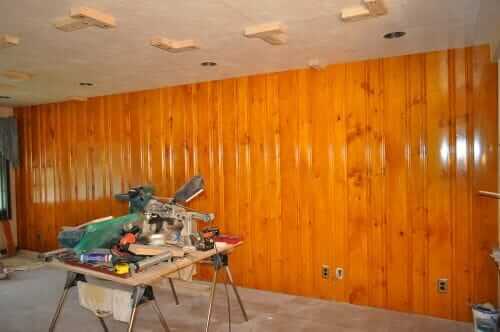
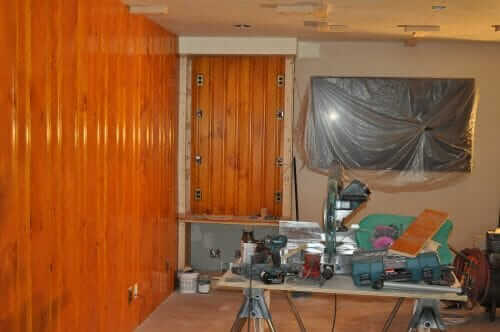
No comments:
Post a Comment